Looking for a good time? Packed with trivia, deeply personal stories, and wacky accounts of scientific inquiry, these 10 books about sex are smart, engaging, occasionally uproarious, and the source of some surprising tips to test when the lights go out.
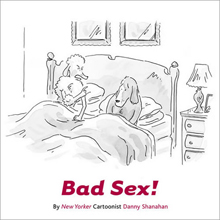
Bad Sex
By Danny Shanahan
128 pages; Abrams, Harry N Inc.
Face it, where sex is concerned, we're animals. Also vegetables (and befuddled humans, young and old), in cartoonist Danny Shanahan's hilarious Bad Sex! (Abrams Image). Scott Spencer's introduction, with its plea to read the book slowly ("Let it caress...your funny bone") should be taken to heart. As the tortoise, bedding the hare, points out, "Hey, it's not a race."
—Cathleen Medwick

By Sharon Moalem
288 pages; HarperCollins
Packed with trivia about the evolutionary history, intricate mechanics, and nitty-gritty mysteries of sex, sexual organs, and desire, Sharon Moalem's How Sex Works manages to inject science writing with the prurient thrill of a gossip rag. Here's a taste:
We like "va-jay-jay," of course:...and "hoo ha" and "honey pot" aren't bad, either. They certainly improve on the 19th-century pet name for the vagina, the "upright grin." But we vote for the revival of the late-1500s slang of choice, "hey nonny-no."
I only have eyes for you... and you: Ovulation, when female fertility is at its peak, is also the time of the month when women are more likely to fantasize about men who aren't their partners. If a woman does have sex with more than one man during ovulation, there's a chance that her wandering eye could lead to fraternal twins with different dads. One study suggested that one in 400 pairs of fraternal twins shares a mom but not a dad.
36-24-36 = genius: Data from the National Center for Health Statistics suggests that children of moms with wide hips but a low waist-to-hip ratio (the classic hourglass figure) score highest on intelligence tests. The explanation? Fatty acids stored in hip fat aid brain development in fetuses—womanly curves create brain power, literally.
— Jessica Winter
288 pages; HarperCollins
Packed with trivia about the evolutionary history, intricate mechanics, and nitty-gritty mysteries of sex, sexual organs, and desire, Sharon Moalem's How Sex Works manages to inject science writing with the prurient thrill of a gossip rag. Here's a taste:
We like "va-jay-jay," of course:...and "hoo ha" and "honey pot" aren't bad, either. They certainly improve on the 19th-century pet name for the vagina, the "upright grin." But we vote for the revival of the late-1500s slang of choice, "hey nonny-no."
I only have eyes for you... and you: Ovulation, when female fertility is at its peak, is also the time of the month when women are more likely to fantasize about men who aren't their partners. If a woman does have sex with more than one man during ovulation, there's a chance that her wandering eye could lead to fraternal twins with different dads. One study suggested that one in 400 pairs of fraternal twins shares a mom but not a dad.
36-24-36 = genius: Data from the National Center for Health Statistics suggests that children of moms with wide hips but a low waist-to-hip ratio (the classic hourglass figure) score highest on intelligence tests. The explanation? Fatty acids stored in hip fat aid brain development in fetuses—womanly curves create brain power, literally.
— Jessica Winter

By Ellen Sussman
304 pages; Bloomsbury
"Orgy is a word that fills your mouth like a wild oyster that's just a little too big to (comfortably) swallow." That's one of many juicy—or unpalatable, depending on your point of view—revelations in Dirty Words: A Literary Encyclopedia of Sex, edited by Ellen Sussman. This compendium of highly personal definitions runs the gamut from A, Adultery to W, Wet Dreams, and includes stories and essays by the likes of Joshua Furst (Cybersex), Patricia Marx (Vibrator), and Elissa Schappell (Exhibitionist). Among the stellar celibates listed under C, Celibacy: Isaac Newton, Carol Channing, Antoni Gaudí, and Sigmund Freud, who swore off sex from about the age of 41. This little book of predilections would have knocked him off hiscouch.
— Cathleen Medwick
304 pages; Bloomsbury
"Orgy is a word that fills your mouth like a wild oyster that's just a little too big to (comfortably) swallow." That's one of many juicy—or unpalatable, depending on your point of view—revelations in Dirty Words: A Literary Encyclopedia of Sex, edited by Ellen Sussman. This compendium of highly personal definitions runs the gamut from A, Adultery to W, Wet Dreams, and includes stories and essays by the likes of Joshua Furst (Cybersex), Patricia Marx (Vibrator), and Elissa Schappell (Exhibitionist). Among the stellar celibates listed under C, Celibacy: Isaac Newton, Carol Channing, Antoni Gaudí, and Sigmund Freud, who swore off sex from about the age of 41. This little book of predilections would have knocked him off hiscouch.
— Cathleen Medwick

By Mary Roach
288 pages; Norton
Mary Roach has done it again. Like Stiff, her improbable page-turner about cadavers, Bonk: The Curious Coupling of Science and Sex (Norton) proves that full-bodied research can be riveting—comic, too. Ever alert to "the cringe factor," Roach introduces her reader to all kinds of sexual arcana, e.g., the penis camera (invented because "you can't see the hangar when the airship's in the building"), farmers' pig-insemination techniques, and Napoleon's great-grandniece's surgically relocated clitoris. Roach even bribes her husband to join her as a guinea pig. Tip: For a good time, read the footnotes.
— Cathleen Medwick
288 pages; Norton
Mary Roach has done it again. Like Stiff, her improbable page-turner about cadavers, Bonk: The Curious Coupling of Science and Sex (Norton) proves that full-bodied research can be riveting—comic, too. Ever alert to "the cringe factor," Roach introduces her reader to all kinds of sexual arcana, e.g., the penis camera (invented because "you can't see the hangar when the airship's in the building"), farmers' pig-insemination techniques, and Napoleon's great-grandniece's surgically relocated clitoris. Roach even bribes her husband to join her as a guinea pig. Tip: For a good time, read the footnotes.
— Cathleen Medwick
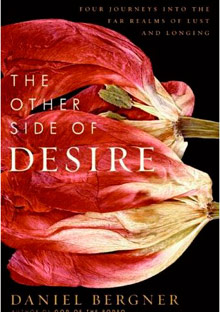
By Daniel Bergner
224 pages; Ecco
The people you'll meet! A family man agonizingly obsessed with feet; a clothing designer and "evangelical sadist," sheathed in skintight latex, who believes she's saving the world; a telecom techie with a yen for his preteen stepdaughter; an art director attracted to disabled women who are (quite literally) not all there. And no, these are not monsters, but outcasts whose first, melancholy question to journalist Daniel Bergner is often "What...are you doing here with me?" Girded with scientific data about the nature of sexual identity, The Other Side of Desire is a foray into extreme passion, in quest of the human soul.
— Cathleen Medwick
224 pages; Ecco
The people you'll meet! A family man agonizingly obsessed with feet; a clothing designer and "evangelical sadist," sheathed in skintight latex, who believes she's saving the world; a telecom techie with a yen for his preteen stepdaughter; an art director attracted to disabled women who are (quite literally) not all there. And no, these are not monsters, but outcasts whose first, melancholy question to journalist Daniel Bergner is often "What...are you doing here with me?" Girded with scientific data about the nature of sexual identity, The Other Side of Desire is a foray into extreme passion, in quest of the human soul.
— Cathleen Medwick

By Susan Cheever
192 pages; Simon & Schuster
In Desire: Where Sex Meets Addiction, author Susan Cheever investigates the realm in which making love becomes a compulsive behavior. Cheever, whose previous work includes several novels and memoirs, was inspired to write about the subject in part by researching My Name Is Bill, her recent biography of Bill Wilson, the co-founder of Alcoholics Anonymous. According to numerous accounts, he was not only an alcoholic but also a sex addict, a lifelong problem that cost him the respect of many of his colleagues in the AA movement. Cheever's book promises to provoke readers, who may recognize states of mind and patterns of behavior—their own or others'—that have caused them pain. One revelation likely to prompt glimpses of self-recognition: The leagues of relationship addicts include both compulsive sex-seekers and "in love with love" types who consistently choose infatuation over long-term commitment. Indeed, the book suggests that "in love" is a dangerous state, to be navigated before proceeding to marriage.
In exploring desire, Cheever offers tales of her own sexual promiscuity, with incisive commentary from experts on the neuroscience and psychology of addictive behavior. Amid increasing evidence that people hooked on sex, alcohol, and other drugs share common traits, Cheever describes an "otherworldly suspension of will" that overcomes addicts, which can propel them to "use" despite prior resolve. The loss of will seems to result from the activation of similar brain pathways no matter what the fix is (many addicts, including Susan's father, author John Cheever, whose recovery from alcoholism led her to write her biography of Wilson, are attracted to more than one agent; in fact, it was Bill W.'s dependence on nicotine that ended up killing him). Cheever echoes the opinion of many scientific experts that sex addiction should be treated not as a failure of morality or character but as a disease of brain biochemistry resulting from a combination of genetics and life events.
— Gabrielle Leblanc
192 pages; Simon & Schuster
In Desire: Where Sex Meets Addiction, author Susan Cheever investigates the realm in which making love becomes a compulsive behavior. Cheever, whose previous work includes several novels and memoirs, was inspired to write about the subject in part by researching My Name Is Bill, her recent biography of Bill Wilson, the co-founder of Alcoholics Anonymous. According to numerous accounts, he was not only an alcoholic but also a sex addict, a lifelong problem that cost him the respect of many of his colleagues in the AA movement. Cheever's book promises to provoke readers, who may recognize states of mind and patterns of behavior—their own or others'—that have caused them pain. One revelation likely to prompt glimpses of self-recognition: The leagues of relationship addicts include both compulsive sex-seekers and "in love with love" types who consistently choose infatuation over long-term commitment. Indeed, the book suggests that "in love" is a dangerous state, to be navigated before proceeding to marriage.
In exploring desire, Cheever offers tales of her own sexual promiscuity, with incisive commentary from experts on the neuroscience and psychology of addictive behavior. Amid increasing evidence that people hooked on sex, alcohol, and other drugs share common traits, Cheever describes an "otherworldly suspension of will" that overcomes addicts, which can propel them to "use" despite prior resolve. The loss of will seems to result from the activation of similar brain pathways no matter what the fix is (many addicts, including Susan's father, author John Cheever, whose recovery from alcoholism led her to write her biography of Wilson, are attracted to more than one agent; in fact, it was Bill W.'s dependence on nicotine that ended up killing him). Cheever echoes the opinion of many scientific experts that sex addiction should be treated not as a failure of morality or character but as a disease of brain biochemistry resulting from a combination of genetics and life events.
— Gabrielle Leblanc
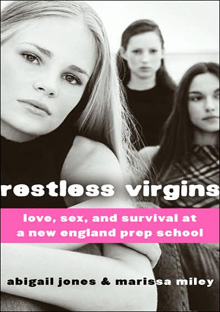
By Abigail Jones
304 pages; HarperCollins
Apparently, you don’t need to strand teenagers on a desert island to re-create the primal horrors we all remember unfolding in Lord of the Flies. In their first book, Restless Virgins: Love, Sex, and Survival at a New England Prep School (Morrow), Abigail Jones and Marissa Miley conduct an exhaustive series of interviews with students about life at the elite Milton Academy in an attempt to understand the sex scandal that rocked the school in 2005. What they discover—the power plays, harassment, and all-consuming pressure to be "the best"—is not exactly news, but as they chip away at the pervasive climate of unrelenting promiscuity and out-of-control partying, it is clear that something is very wrong in the life of contemporary teens. Milton is a provocative petri dish for Jones and Miley to have chosen. Founded in 1798, its alum include T.S. Eliot and Robert Kennedy as well as Jones and Miley themselves. When scandalous accounts of the sexual practices of the current generation of students culminated in the expulsion and subsequent charges of statutory rape against five "hockey gods" who had oral sex with a 15-year-old girl, the authors committed themselves to finding out what was going on. Over two years, they conducted hundreds of interviews with students, as well as teachers and parents, before ultimately focusing on the interlinked stories of seven girls and boys to reveal the casual hookups, off-campus binges, and sheer desperation to be popular (equated with "sexually desirable" by all of them) that define life for these kids. Shortly before graduation, having lived through the ups and downs of college admissions and the glare of negative press attention, they slowly back away from the drinking, drugging, and "liberation" that feels more like abuse, and reach for a truer sense of how they want to treat others and be treated themselves. But, as Jones and Miley expertly document, today’s teens have come a long way from simply worrying about a date for the prom. . Yet, David writes, "The constellation of these impulses that we call love feels like a miracle."
— Elaina Richardson
304 pages; HarperCollins
Apparently, you don’t need to strand teenagers on a desert island to re-create the primal horrors we all remember unfolding in Lord of the Flies. In their first book, Restless Virgins: Love, Sex, and Survival at a New England Prep School (Morrow), Abigail Jones and Marissa Miley conduct an exhaustive series of interviews with students about life at the elite Milton Academy in an attempt to understand the sex scandal that rocked the school in 2005. What they discover—the power plays, harassment, and all-consuming pressure to be "the best"—is not exactly news, but as they chip away at the pervasive climate of unrelenting promiscuity and out-of-control partying, it is clear that something is very wrong in the life of contemporary teens. Milton is a provocative petri dish for Jones and Miley to have chosen. Founded in 1798, its alum include T.S. Eliot and Robert Kennedy as well as Jones and Miley themselves. When scandalous accounts of the sexual practices of the current generation of students culminated in the expulsion and subsequent charges of statutory rape against five "hockey gods" who had oral sex with a 15-year-old girl, the authors committed themselves to finding out what was going on. Over two years, they conducted hundreds of interviews with students, as well as teachers and parents, before ultimately focusing on the interlinked stories of seven girls and boys to reveal the casual hookups, off-campus binges, and sheer desperation to be popular (equated with "sexually desirable" by all of them) that define life for these kids. Shortly before graduation, having lived through the ups and downs of college admissions and the glare of negative press attention, they slowly back away from the drinking, drugging, and "liberation" that feels more like abuse, and reach for a truer sense of how they want to treat others and be treated themselves. But, as Jones and Miley expertly document, today’s teens have come a long way from simply worrying about a date for the prom. . Yet, David writes, "The constellation of these impulses that we call love feels like a miracle."
— Elaina Richardson
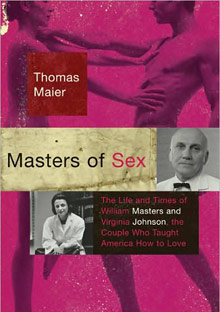
By Thomas Maier
432 pages; Basic Books
It's shocking to realize how little we knew about the physiology of sex—female sexuality, in particular—until the 1950s, when gynecological surgeon William Masters set up a semiclandestine laboratory at a university in St. Louis and, together with his assistant, Virginia Johnson, employed the latest technology (a plastic penis equipped with a camera!) and volunteer subjects to record what happens during the act. Illuminating the previously misunderstood and underestimated female orgasm, their findings (published in the 1966 best-seller Human Sexual Response) were an important factor in heating up the sexual climate of the 1960s. The increasingly successful researchers helped many grateful couples, who flocked to their clinic with their most intimate problems. But science failed to do much for Masters and Johnson themselves. Sex with her boss was understood to be part of the job description for Virginia Johnson, an attractive divorced single mother, yet when Masters finally left his wife for her, their marriage was a chilly professional partnership, sadly devoid of love—a mystery their experiments had left unexplored. Perhaps influenced by its steamy subject matter, Masters of Sex, Thomas Maier's new book about the couple's career, may strike some readers as unusually graphic for a biography, but this unsettling story of sex and science in theory and practice is ultimately more cautionary than titillating.
— Francine Prose
432 pages; Basic Books
It's shocking to realize how little we knew about the physiology of sex—female sexuality, in particular—until the 1950s, when gynecological surgeon William Masters set up a semiclandestine laboratory at a university in St. Louis and, together with his assistant, Virginia Johnson, employed the latest technology (a plastic penis equipped with a camera!) and volunteer subjects to record what happens during the act. Illuminating the previously misunderstood and underestimated female orgasm, their findings (published in the 1966 best-seller Human Sexual Response) were an important factor in heating up the sexual climate of the 1960s. The increasingly successful researchers helped many grateful couples, who flocked to their clinic with their most intimate problems. But science failed to do much for Masters and Johnson themselves. Sex with her boss was understood to be part of the job description for Virginia Johnson, an attractive divorced single mother, yet when Masters finally left his wife for her, their marriage was a chilly professional partnership, sadly devoid of love—a mystery their experiments had left unexplored. Perhaps influenced by its steamy subject matter, Masters of Sex, Thomas Maier's new book about the couple's career, may strike some readers as unusually graphic for a biography, but this unsettling story of sex and science in theory and practice is ultimately more cautionary than titillating.
— Francine Prose
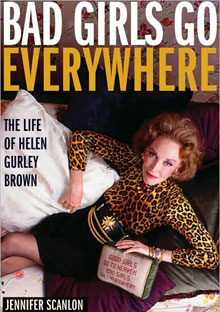
By Jennifer Scanlon
288 pages; Oxford
Kicking up her stiletto heels and touting a cavalier sexiness-for-fun-and-profit approach to love and work (not to mention love at work), Helen Gurley Brown wrote the 1962 best-seller Sex and the Single Girl, later editing Cosmopolitan magazine and alarming generations of feminists with her lusty embrace of the status quo. But as Jennifer Scanlon, a professor of gender and women's studies, argues in Bad Girls Go Everywhere, Brown's "lipstick feminism" was always a liberating proposition. Scanlon's shrewd biography reveals a woman of contradictions (e.g., Brown is happily monogamous), a strategically racy cultural pioneer.
— Cathleen Medwick
288 pages; Oxford
Kicking up her stiletto heels and touting a cavalier sexiness-for-fun-and-profit approach to love and work (not to mention love at work), Helen Gurley Brown wrote the 1962 best-seller Sex and the Single Girl, later editing Cosmopolitan magazine and alarming generations of feminists with her lusty embrace of the status quo. But as Jennifer Scanlon, a professor of gender and women's studies, argues in Bad Girls Go Everywhere, Brown's "lipstick feminism" was always a liberating proposition. Scanlon's shrewd biography reveals a woman of contradictions (e.g., Brown is happily monogamous), a strategically racy cultural pioneer.
— Cathleen Medwick
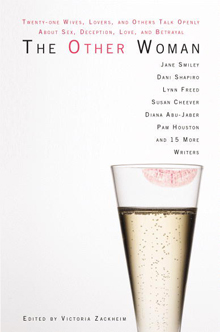
By Victoria Zackheim
288 pages; Grand Central Publishing
"Invite the bitch to dinner" is one wickedly brash survival strategy in The Other Woman: Twenty-one Wives, Lovers, and Others Talk Openly About Sex, Deception, Love, and Betrayal, edited by Victoria Zackheim (Warner). Among the star turns in this unusually frank and furious collection of essays are Pam Houston’s "Not Istanbul," a hypothetical journey into an impossibly complicated relationship ("Here’s the thing about the other woman. She lives inside your head") and Connie May Fowler’s "The Uterine Blues," a savory bit of rancor from a woman scorned.
— Cathleen Medwick
Looking for another great book? Find hundreds of ideas from O's Reading Room!
288 pages; Grand Central Publishing
"Invite the bitch to dinner" is one wickedly brash survival strategy in The Other Woman: Twenty-one Wives, Lovers, and Others Talk Openly About Sex, Deception, Love, and Betrayal, edited by Victoria Zackheim (Warner). Among the star turns in this unusually frank and furious collection of essays are Pam Houston’s "Not Istanbul," a hypothetical journey into an impossibly complicated relationship ("Here’s the thing about the other woman. She lives inside your head") and Connie May Fowler’s "The Uterine Blues," a savory bit of rancor from a woman scorned.
— Cathleen Medwick
Looking for another great book? Find hundreds of ideas from O's Reading Room!




